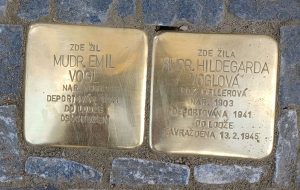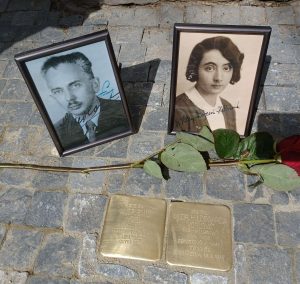 Address: MÁNESOVA 1374/53, PRAGUE 2
Address: MÁNESOVA 1374/53, PRAGUE 2
Born: 1901
Deported to Lodž
Liberated
Emil Vogl was born on 21 May 1901 in a Jewish German family in Karlín to Josef and Augusta Vogl. He had three brothers. Although he came from a poor background, he managed to graduate from the German Gymnasium and the Faculty of Medicine of the German University in Prague and was graduated as a doctor in 1926. After a few years of practice in a propaedeutic clinic, he opened a private practice in 1930, specializing in internal medicine.
In 1929 he married his classmate Hildegard Heller, who set up a radiology practice. They lived and practised first in Štěpánská Street, and from 1935 in Lützowova Street. From his student days Emil Vogl was interested in woodcraft and was involved in the activities of the Forest Wisdom League, and was a member of the Prager Neupfadfinder, a tribe of mostly German Jews. In the 1930s he founded the Bund internationaler Jugend – a bilingual association for German, Jewish-German and Czech children. His wife Hilda led the girls’ section in the union.
In 1940, Jews were forbidden to practice medicine, so he continued to treat patients secretly. On 31 October 1941, Emil Vogl, his wife Hildegard and her mother Klára Heller were deported by transport D from Prague to Lodz. Here Emil Vogl was assigned as a doctor to the so-called Gypsy camp. After the outbreak of the typhus epidemic, all the camp residents died, only Emil Vogl survived. Before his deportation to Chelmno in November 1943, Emil Vogl was saved by another typhus epidemic, this time in the concentration camp for under-age prisoners in Lodz, where he was assigned as a doctor, and thanks to him the epidemic was contained. After the liquidation of the Lodz ghetto, Emil Vogl was transferred to Auschwitz (28 August 1944) and from there to other camps (Gross-Rosen, Teplice, Reichenau).
After the liberation he returned to Prague, where he learned of the death of his wife and many other relatives. He was treated for the effects of the war hardships in the Prague Sanatorium in Podolí. There, his friend from the Forest Wisdom League, Míla Vavrda, sought him out and put him in contact with Přemysl Pitter, who was organizing a rescue action for children returning from concentration camps, the so-called “operation castles”, and was looking for doctors for these children. Emil Vogl then spent two years treating children at the Medical House in Olešovice – not only children from the concentration camps, but also German children from the internment camps.
In 1948, Emil Vogl married for the second time to Růžena Haasová and worked as a doctor in state health centres until 1969, when he retired. He liked to spend his spare time with his friends from Woodcraft at the cottage in Samechov and also devoted himself deeply to his old hobby – playing the lute and musical research in this field. He wrote many scholarly articles on the lute and thanks to his efforts many old lute compositions have survived to the present time. He died on 3 June 1977 and is buried in the New Jewish Cemetery in Strašnice.
